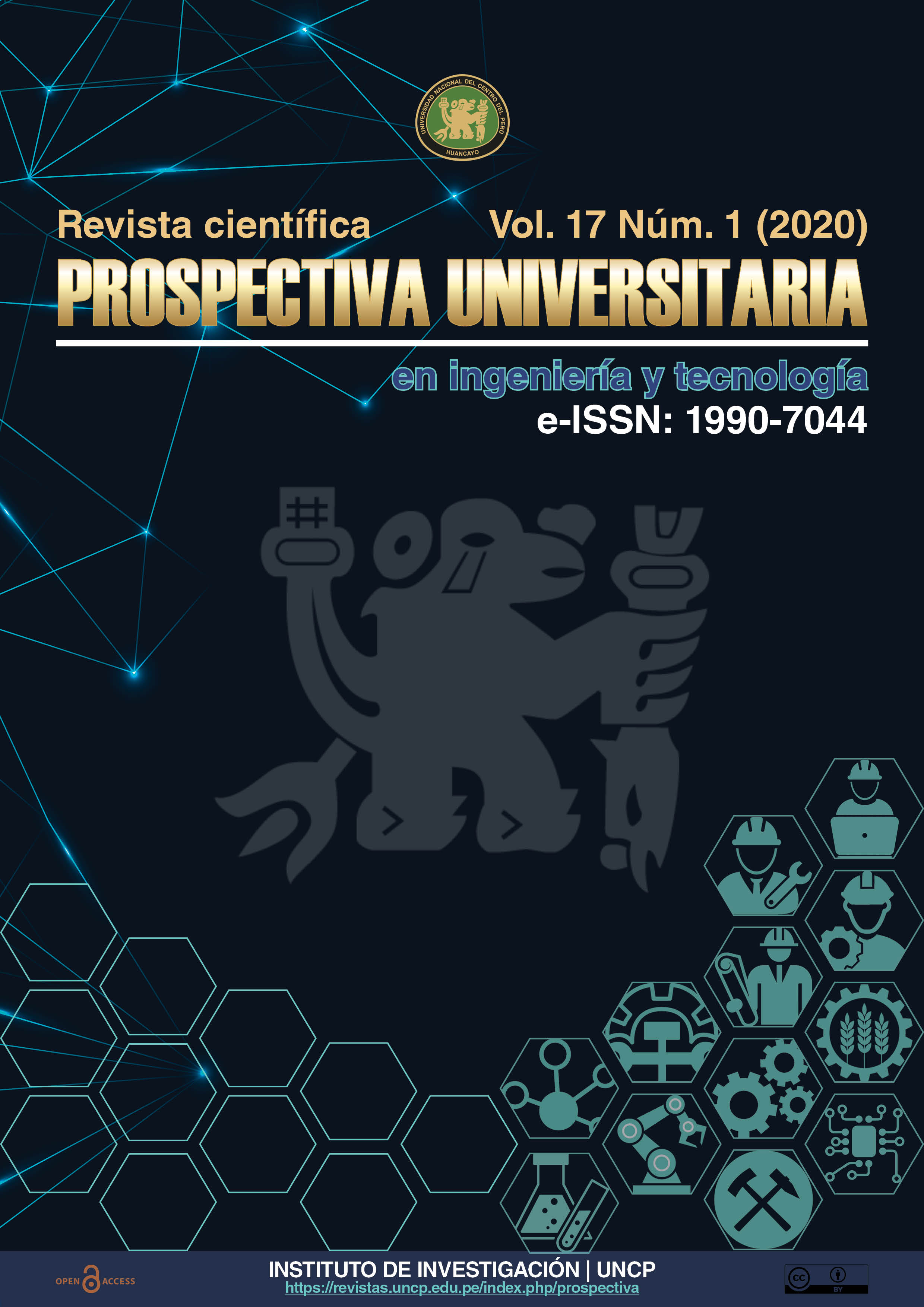Pretratamiento ácido de residuos de Apio (Apium Graveolens)
DOI:
https://doi.org/10.26490/uncp.prospectivauniversitaria.2020.17.1396Palabras clave:
Residuos de apio, Pretratamiento ácido, CelulosaResumen
En la investigación se determinó la influencia del tiempo, temperatura y dosis de H2SO4 en las características de la celulosa y concentración de glucosa en el pretratamiento ácido de los residuos de apio, de tal manera que los residuos de apio pretratados tengas las mejores condiciones para la hidrólisis y posterior fermentación, y tener como producto final etanol. La parte experimental consistió en colectar y preparar los residuos de apio, preparar el reactivo DNS y elaborar la curva de calibración de la glucosa que sirve para determinar la concentración de azucares reductores, realizar el pretratamiento ácido a 25 g de residuos en cada experimento y determinar la morfología de la celulosa con el microscopio de barrido electrónico (SEM) Mira 3 Tescan. Las variables que se evaluó son la concentración del H2SO4 (0.1%, 2.5% y 4.0%), temperatura (60, 70 y 80 °C) y tiempo (2, 3 y 4 horas) y se siguió las experimentaciones del diseño experimental. De las pruebas iniciales, los niveles bajos de las variables son las mejores condiciones del pretratamiento ácido por la morfología que presentan que concuerdan con lo indicado en la literatura, con ello la producción de glucosa en la hidrólisis será mayor y etanol en la fermentación.
Descargas
Referencias
Cekmecelioglu D, Uncu ON. Kinetic modeling of enzymatic hydrolysis of pretreated kitchen wastes for enhancing bioethanol production. Waste Manag [Internet]. 2013;33(3):735–9. Available from: http://dx.doi.org/10.1016/j.wasman.2012.08.003
Vavouraki AI, Volioti V, Kornaros ME. Optimization of thermo-chemical pretreatment and enzymatic hydrolysis of kitchen wastes. Waste Manag [Internet]. 2014;34(1):167–73. Available from: http://dx.doi.org/10.1016/j.wasman.2013.09.027
Uncu ON, Cekmecelioglu D. Cost-effective approach to ethanol production and optimization by response surface methodology. Waste Manag [Internet]. 2011;31(4):636–43. Available from: http://dx.doi.org/10.1016/j.wasman.2010.12.007
Ntaikou I, Menis N, Alexandropoulou M, Antonopoulou G, Lyberatos G. Valorization of kitchen biowaste for ethanol production via simultaneous saccharification and fermentation using co-cultures of the yeasts Saccharomyces cerevisiae and Pichia stipitis. Bioresour Technol [Internet]. 2018;263:75–83. Available from: https://doi.org/10.1016/j.biortech.2018.04.109
Negi H, Agrawal R, Verma A, Goel R. Municipal solid waste to bioenergy: Current status, opportunities, and challenges in Indian context [Internet]. New and Future Developments in Microbial Biotechnology and Bioengineering. Elsevier B.V.; 2019. 191–203 p. Available from: http://dx.doi.org/10.1016/B978-0-444-64191-5.00014-6
Zabot GL, Tres M V., Ferreira PAA, Dal Molin A, Mazutti MA. Power the future with bioenergy from organic wastes. In: Recent Developments in Bioenergy Research [Internet]. BV; 2020. p. 85–114. Available from: http://dx.doi.org/10.1016/B978-0-12-819597-0.00004-0
Trivedi J, Bhonsle AK, Atray N. Processing food waste for the production of platform chemicals [Internet]. Refining Biomass Residues for Sustainable Energy and Bioproducts. Elsevier Inc.; 2020. 427–448 p. Available from: http://dx.doi.org/10.1016/B978-0-12-818996-2.00019-3
Demesa AG, Laari A, Sillanpää M. Value-added chemicals and materials from lignocellulosic biomass [Internet]. Advanced Water Treatment. Elsevier Inc.; 2020. 367–436 p. Available from: http://dx.doi.org/10.1016/B978-0-12-819225-2.00006-5
Hendriks ATWM, Zeeman G. Pretreatments to enhance the digestibility of lignocellulosic biomass. Bioresour Technol. 2009;100(1):10–8.
Otles S, Kartal C. Food waste valorization [Internet]. Sustainable Food Systems from Agriculture to Industry. Elsevier Inc.; 2018. 371–399 p. Available from: http://dx.doi.org/10.1016/B978-0-12-811935-8.00011-1
Speight JG. Hydrocarbons from biomass. Handbook of Industrial Hydrocarbon Processes. 2020. 293–342 p.
Verardi A, Lopresto CG, Blasi A, Chakraborty S, Calabrò V. Bioconversion of lignocellulosic biomass to bioethanol and biobutanol [Internet]. Lignocellulosic Biomass to Liquid Biofuels. INC; 2020. 67–125 p. Available from: http://dx.doi.org/10.1016/B978-0-12-815936-1.00003-4
Bajpai P. Biomass conversion processes. Biomass to Energy Conversion Technologies. 2020. 41–151 p.
Dey P, Pal P, Kevin JDi, Das DiB. Lignocellulosic bioethanol production: Prospects of emerging membrane technologies to improve the process - A critical review. Rev Chem Eng. 2018;
Chiaramonti D, Giovannini A, Janssen R, Mergner R. Lignocellulosic ethanol production plant by Biochemtex in Italy Lignocellulosic Ethanol Process and Demonstration A Handbook Part I [Internet]. 2013. 140 p. Available from: www.wip-munich.de
Ranjithkumar M, Ravikumar R, Sankar MK, Kumar MN, Thanabal V. An effective conversion of cotton waste biomass to ethanol: A critical review on pretreatment processes. Waste and Biomass Valorization. 2017;8(1):57–68.
Núñez RÁ, Pérez BR, Hernández R, Nacional U, Francisco E, Perozos NAL. Contenido de azúcares totales, reductores y no reductores en Agave cocui Trelease. Multiciencias. 2012;12(2):129–35.
Sarabandi K, Gharehbeglou P, Jafari SM. Scanning electron microscopy (SEM) of nanoencapsulated food ingredients [Internet]. Characterization of Nanoencapsulated Food Ingredients. Elsevier Inc.; 2020. 83–130 p. Available from: http://dx.doi.org/10.1016/B978-0-12-815667-4.00003-1
Vladár AE, Hodoroaba VD. Characterization of nanoparticles by scanning electron microscopy [Internet]. Characterization of Nanoparticles: Measurement Processes for Nanoparticles. Elsevier Inc.; 2019. 7–27 p. Available from: http://dx.doi.org/10.1016/B978-0-12-814182-3.00002-X
Descargas
Publicado
Número
Sección
Licencia
Derechos de autor 2020 Eufracio Arias, Wilder E.

Esta obra está bajo una licencia internacional Creative Commons Atribución-NoComercial-CompartirIgual 4.0.
Esta Revista es de acceso abierto a su contenido a través del Internet, poniendo a disposición de la comunidad científica los resultados de la investigación, de manera gratuita, para el intercambio del conocimiento desarrollado.
El contenidos de la Revista se distribuyen bajo la licencia Creative Commons Reconocimiento-NoComercial-CompartirIgual 4.0 Internacional.
![IconJournalPU [ESP] by Edgar Julian-Laime®](https://revistas.uncp.edu.pe/public/journals/1/pageHeaderLogoImage_es.png)









